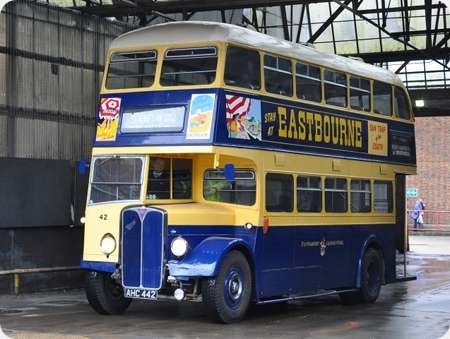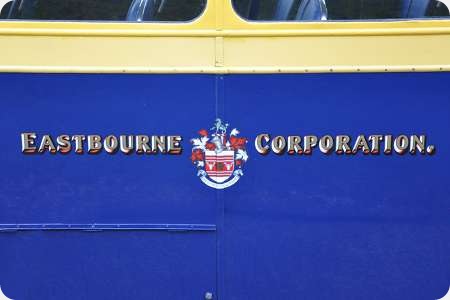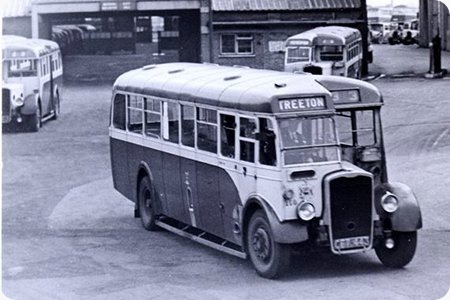Eastbourne Corporation - AEC Regent III - AHC 442 - 42
Eastbourne Corporation
1951
AEC Regent III 9613A
Bruce H30/26R
This AEC Regent III 9613A with Bruce H56R body was new in 1951 and our first view shows her inside the bus depot. Actually, that isn’t where we see her, as any Eastbourne enthusiast might tell you! She is, in fact, passing through the garage area at the back of Winchester Bus Station whilst taking part in the King Alfred Running Day on 1 January 2012. The second view shows her fleetname and crest.
Photograph and Copy contributed by Pete Davies
29/10/15 - 06:36
Thank you Pete Davies for letting us see this picture of Eastbourne
Corporation, Fleet No.42 - AHC 442.
This bus brings back happy memories of my time at Derby
Borough/City Transport from 1975 to 1980.
Why I hear you ask, should an Eastbourne Corporation
bus remind me of Derby, as they never operated such vehicles.
Well the answer is this.
At that time, 42, was owned by the late Gerald Truran the Chief Engineer at Derby, and was
garaged at either Ascot Drive Depot or Osmaston Road Depot, depending on where there was space for
it.
During the Summer months of the Rally season, we used to take it to many a rally, and I
used to share the Driving with Gerald. It was a superb bus to drive, the Driving position was second
to none and Gerald kept it in first class condition, and it could achieve a fair turn of speed, (not
just downhill), and the gearbox, once mastered, was a delight in itself. The body and paint work
were superb and I recall leaving a few rally fields with silverware on board.
I left Derby in
June 1980 to work at Darlington Corporation Transport, and whilst we had our own Daimler deckers
still in service they were not the same as that AEC.
I never saw 42 again until a couple of
years ago,when I was at the Worthing Seafront Bus Rally, and whilst I was allowed on board to take a
few pictures, permission was not forth coming to climb up into the cab to sample that pleasure again
(simple things please and amuse old Busmen).
It is nice to see her again if only in print, and
brings back happy times, not just driving her, but of my 5+ years at Derby.
Stephen Howarth
29/10/15 - 15:45
A bit of serendipity as this picture comes on the day that I had a query from
an ex-colleague as to whether there are still any instances of bus garages being used as bus
stations. This arose from some pictures of Worksop where a new bus station has recently replaced the
stands outside the former East Midland MS garage which doubled for many years as the town’s bus
station. (I would have uploaded my shot of Tiger Cub R39 in this location except that it would more
or less duplicate this existing picture on this site at //www.old-bus-photos.co.uk/?p=2817)
I get the impression
that at Winchester the stands are not inside the main building, but does anyone know of anywhere
where a building is still shared by garage and passenger facilities?
Alan Murray-Rust
29/10/15 - 17:14
What memories there are in this photo as I began my 42 years on the buses with
Eastbourne Corporation at Churchdale road depot in August 1961. In those days everyone started as a
conductor and when the chance arose went on to the driving school, undertaken in your own time,
where Leyland PD1/Bruce No 15 JK 9113 awaited your tender touch. Having passed my test at the first
attempt in April 1962 I progressed to the drivers roster after some tuition on the various different
types then in the fleet which of course included the Regent III’s like No 42.
At that time
they were often referred to as the "Hampden Park" buses as they were used almost solely on
the 7, 7a, 9 and 9a routes which were tightly timed and interworked as their lively performance was
a great help with time keeping which made them very popular with all drivers and one of everyone’s
favourites.
I have to agree with all Stephen Howarths favourable comments regarding these
buses which were solid reliable and comfortable, No 42 is now owned by a group in the Portsmouth
area one of who is a friend Clive Wilkin.
Diesel Dave
30/10/15 - 06:37
What about Marlborough St Bristol that used to be one.
Roger Burdett
30/10/15 - 06:38
I loves Eastbourne’s livery of this period. As bright as a seaside funfair and most ususual in keeping the under canopy and bonnet top the same colour as the sides - a very ‘thirties feature. All-round, a very attractive vehicle.
Chris Hebbron
30/10/15 - 06:39
Thanks for your comments, chaps. Alan, you are correct in thinking that, in Winchester, the garage is at the back of the Bus Station. Make the most of it, though, as redevelopment looms!
Pete Davies
01/11/15 - 05:59
Roger, "used to be one" is correct - now completely redeveloped as a bus station only. But, yesterday, I alighted from a trentbarton "seven" inside the "old" Belper bus station/depot - the (upper) maintenance bay is now used by a tyre company, but if buses still overnight in the (lower) bus station area . . .
Philip Rushworth
02/11/15 - 06:48
My first memory of these fine vehicles was as a child in 1953 somebody in my street in the old town area of Eastbourne hired a corporation bus to take us to a fireworks display on the seafront to celebrate the Queens Coronation and it was one of these 40 types as Diesel Dave has said these buses had a distinctive tone. As Dave has said every body on Eastbourne Corporation started as a conductor so when I started in 1968 it was the same for me when I entered the driving school in 1969 the training bus was 42s sister vehicle 47 that was the start of a very interesting career for me I followed Dave to Southdown though it was a NBC Southdown Dave and I worked the early days of National Express I’m now still driving Working for one of the major companies on a part time bases working in and out of one of our big cites I’m now just starting my 47th year as a bus driver.
Tony Grover
02/11/15 - 06:49
Last time I was there, Malton still seemed to be a combined bus station/depot
Michael Keeley
02/11/15 - 06:50
Yes, they do. I think it is still 7 ’55’ reg. Scania L94/Wrights for the "sixes" service, and 2 Solo for the "sevens" service. Recently, a new roller door has been installed, headroom stated at 14′, so no more highbridge double deckers!
Allan White
Quick links to the - Comments Page - Contact Page - Home Page



